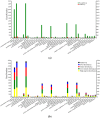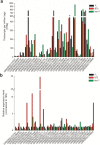Heterosis in early maize ear inflorescence development: a genome-wide transcription analysis for two maize inbred lines and their hybrid
- PMID: 25116687
- PMCID: PMC4159830
- DOI: 10.3390/ijms150813892
Heterosis in early maize ear inflorescence development: a genome-wide transcription analysis for two maize inbred lines and their hybrid
Abstract
Heterosis, or hybrid vigor, contributes to superior agronomic performance of hybrids compared to their inbred parents. Despite its importance, little is known about the genetic and molecular basis of heterosis. Early maize ear inflorescences formation affects grain yield, and are thus an excellent model for molecular mechanisms involved in heterosis. To determine the parental contributions and their regulation during maize ear-development-genesis, we analyzed genome-wide digital gene expression profiles in two maize elite inbred lines (B73 and Mo17) and their F1 hybrid using deep sequencing technology. Our analysis revealed 17,128 genes expressed in these three genotypes and 22,789 genes expressed collectively in the present study. Approximately 38% of the genes were differentially expressed in early maize ear inflorescences from heterotic cross, including many transcription factor genes and some presence/absence variations (PAVs) genes, and exhibited multiple modes of gene action. These different genes showing differential expression patterns were mainly enriched in five cellular component categories (organelle, cell, cell part, organelle part and macromolecular complex), five molecular function categories (structural molecule activity, binding, transporter activity, nucleic acid binding transcription factor activity and catalytic activity), and eight biological process categories (cellular process, metabolic process, biological regulation, regulation of biological process, establishment of localization, cellular component organization or biogenesis, response to stimulus and localization). Additionally, a significant number of genes were expressed in only one inbred line or absent in both inbred lines. Comparison of the differences of modes of gene action between previous studies and the present study revealed only a small number of different genes had the same modes of gene action in both maize seedlings and ear inflorescences. This might be an indication that in different tissues or developmental stages, different global expression patterns prevail, which might nevertheless be related to heterosis. Our results support the hypotheses that multiple molecular mechanisms (dominance and overdominance modes) contribute to heterosis.
Figures



Similar articles
-
Comparative transcriptomic analysis of maize ear heterosis during the inflorescence meristem differentiation stage.BMC Plant Biol. 2022 Jul 18;22(1):348. doi: 10.1186/s12870-022-03695-6. BMC Plant Biol. 2022. PMID: 35843937 Free PMC article.
-
Identification and characterization of a repertoire of genes differentially expressed in developing top ear shoots between a superior hybrid and its parental inbreds in Zea mays L.Mol Genet Genomics. 2013 Dec;288(12):691-705. doi: 10.1007/s00438-013-0781-5. Epub 2013 Oct 22. Mol Genet Genomics. 2013. PMID: 24146224
-
Transcriptome profiling and comparison of maize ear heterosis during the spikelet and floret differentiation stages.BMC Genomics. 2016 Nov 22;17(1):959. doi: 10.1186/s12864-016-3296-8. BMC Genomics. 2016. PMID: 27875998 Free PMC article.
-
Towards the molecular basis of heterosis.Trends Plant Sci. 2007 Sep;12(9):427-32. doi: 10.1016/j.tplants.2007.08.005. Epub 2007 Aug 27. Trends Plant Sci. 2007. PMID: 17720610 Review.
-
Molecular dissection of heterosis in cereal roots and their rhizosphere.Theor Appl Genet. 2023 Jul 20;136(8):173. doi: 10.1007/s00122-023-04419-6. Theor Appl Genet. 2023. PMID: 37474870 Free PMC article. Review.
Cited by
-
Hybrid mimics and hybrid vigor in Arabidopsis.Proc Natl Acad Sci U S A. 2015 Sep 1;112(35):E4959-67. doi: 10.1073/pnas.1514190112. Epub 2015 Aug 17. Proc Natl Acad Sci U S A. 2015. PMID: 26283378 Free PMC article.
-
Genome-wide proteomic profiling reveals the role of dominance protein expression in heterosis in immature maize ears.Sci Rep. 2017 Nov 23;7(1):16130. doi: 10.1038/s41598-017-15985-3. Sci Rep. 2017. PMID: 29170427 Free PMC article.
-
QTL for Maize Midparent Heterosis in the Heterotic Pattern American Dent × European Flint under Corn Borer Pressure.Front Plant Sci. 2017 Apr 19;8:573. doi: 10.3389/fpls.2017.00573. eCollection 2017. Front Plant Sci. 2017. PMID: 28469629 Free PMC article.
-
Transcriptome analysis of neo-tetraploid rice reveals specific differential gene expressions associated with fertility and heterosis.Sci Rep. 2017 Jan 10;7:40139. doi: 10.1038/srep40139. Sci Rep. 2017. PMID: 28071676 Free PMC article.
-
Dynamic patterns of gene expression and regulatory variation in the maize seed coat.BMC Plant Biol. 2023 Feb 7;23(1):82. doi: 10.1186/s12870-023-04078-1. BMC Plant Biol. 2023. PMID: 36750803 Free PMC article.
References
-
- Shull G.H. The composition of a field of maize. J. Hered. 1908;4:296–301. doi: 10.1093/jhered/os-4.1.296. - DOI
-
- Bruce A.B. The Mendelian theory of heredity and the augmentation of vigor. Science. 1910;32:627. - PubMed
-
- Davenport C.B. Degeneration, albinism and inbreeding. Science. 1908;28:454. - PubMed
Publication types
MeSH terms
Substances
LinkOut - more resources
Full Text Sources
Other Literature Sources

